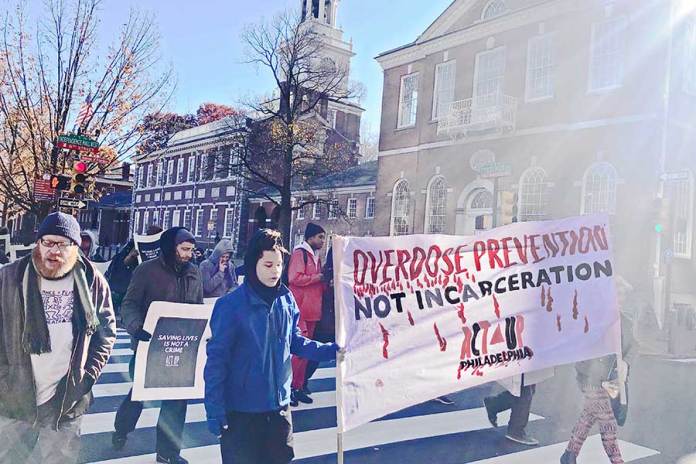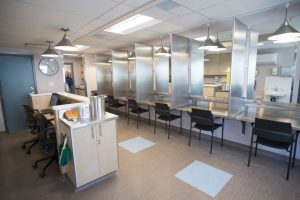“Honestly, the question is not if but when, because there are no other tools in the arsenal [besides Safe Consumption Sites] to effectively manage the overdose crisis.”
-RUSSELL MAYNARD, A SENIOR MANAGER AT PHS COMMUNITY SERVICES SOCIETY
The people of the United States are perhaps the most resilient population on earth. We have weathered multiple wars, an AIDS epidemic, the grim carnage of 911, a prolonged recession in which many lost their life savings, and most recently, a global pandemic. And we have emerged from the darkness with renewed hope and vigor. Yet, the specter of drug addiction, particularly our opioid crisis and its connection to Intravenous Drug Addiction (IDU), threatens to tear our country apart. Consider these sobering statistics:
- Almost 50,000 people die every year from opioid overdose.
- Over 10 million people misuse opioids in a year.
- Opioids are a factor in at least 7 out of every 10 overdose deaths
- 49,860 people overdosed on opioids in 2019.
- 3.8% of American adults abuse opioids each year.
- At least 71.8% and as many as 80% of overdose deaths involve opioids.
- Overdose (OD) deaths involving opioids increased 519.38% from 1999 to 2019.
- 68.0% of all OD deaths are attributed to synthetic opioids.
- Fentanyl and fentanyl analogs are a factor in 19.8% of all overdose deaths.
- 0.7% of hospital births are cases of neonatal opioid withdrawal (NOW) syndrome.
- 2.4 million cases of hepatitis C are attributed to intravenous drug use (IDU).
- 1 million cases of HIV/AIDS are attributed to IDU.
In addition to the staggering human suffering that comes with IDU, the opioid crisis has a tremendous economic impact. According to a report released by the Society of Actuaries, IDU has “cost the U.S. economy $631 billion from 2015-2018.” The specific findings of the report are particularly disturbing:
- Nearly one-third ($205 billion) of the estimated economic burden of the opioid crisis is attributable to excess health care spending for individuals with OUD [Opioid Use Disorder], infants born with neonatal abstinence syndrome
- (NAS) or neonatal opioid withdrawal syndrome (NOWS), and for family members of those with diagnosed OUD.
- Mortality costs accounted for 40% ($253 billion) of the estimated economic impact, predominantly driven by lost lifetime earnings for those who died prematurely due to drug overdoses involving opioids.
- Costs associated with criminal justice activities, including police protection and legal adjudication activities, lost property due to crime, and correctional facility expenditures, totaled $39 billion, roughly 6% of the total cost from 2015 to 2018.
- Costs associated with government-funded child and family assistance programs and education programs contributed another $39 billion over the four-year period.
- Lost productivity costs comprised the remaining 15% of total costs from 2015 through 2018, totaling $96 billion. Lost productivity costs are associated with absenteeism, reduced labor force participation, incarceration for opioid-related crimes, and employer costs for disability and workers’ compensation benefits to employees with OUD.
While the causes are many, there is no doubt the pandemic has exacerbated the trend. A recent report by USA Today highlights this negative dynamic: “Besides increased stress, the pandemic has made it more difficult to access treatment and support services, and it’s interrupted the drug trade, which has led people with substance-use disorders to use alternate, and often more lethal, drugs and combinations of them.”

Safe consumption Sites: A Way Forward?
Regardless of the causes, we can’t as a nation let this juggernaut of an issue go unaddressed. One proposed solution is the creation and maintenance of Safe Consumption Sites (SCS). Also known as Safe Injection Sites (SIS), these centers now operate in more than 120 locations in 66 major cities throughout Europe, Canada, and Australia” according to a Cato report. In simplest terms, SCS “are legally sanctioned and medically supervised facilities that provide a hygienic, safe and secure environment for users of intravenous drugs to imbibe on their illegally acquired substances.” SCS are predicated on the concept of harm reduction, which according to harmreduction.org, “is a set of practical strategies and ideas aimed at reducing negative consequences associated with drug use.”
Although controversial, the idea behind Safe Consumption Sites is straightforward enough. If people have a safe, well-regulated place to inject drugs, they won’t be subject to the myriad of complications of IDU use on the streets. The argument goes that when people have no place to shoot up, they will engage in a number of risky behaviors, such as sharing needles, which leads to the transmission of hepatitis and AIDS, overdosing without medical recourse, and being preyed upon by criminal elements due to their vulnerable state.
And although there are only a few SCS in the United States due to their prohibition by the federal government under the Crack House Statute Law, The American Medical Association points out that “Studies from other countries have shown that supervised injection facilities reduce the number of overdose deaths, reduce transmission rates of infectious disease, and increase the number of individuals initiating treatment for substance use disorders without increasing drug trafficking or crime in the areas where the facilities are located.”
Philadelphia And Safe Consumption Sites
On a more personal level, leaders are starting to clamor for approaches to stem the devastation that is obliterating our cities. Philadelphia is a particularly acute example. As reported by The Philadelphia Inquirer, “Philadelphia is home to the worst urban opioid crisis in America. More than 3,000 people have died of drug overdoses here in the last three years, and the city health department estimates that tens of thousands of Philadelphians are addicted to opioids.”
Philadelphia’s health department has reported that “Philadelphia has an estimated 70,000 heroin users” and that “. . . a scientific review of safe injection sites . . . estimated that a single site in Philadelphia could prevent up to 76 drug overdose deaths per year” while associated cost “saved from averting overdose deaths were estimated at anywhere from $12.5 million to $75 million per year.”
Predictably, prohibition of Safe Consumption Sites has seen an emergence of illegally operated, “shadow” Safe Consumption Sites These centers attempt to fly under the radar of federal government enforcement, making their work more precarious. And according to Kral and Pete Davidson, two researchers at the University of California, San Diego who have studied an illegal site for five years, “There have been more than 10,000 injections at the site, whose location is a fiercely guarded secret, and dozens of overdoses — but zero deaths.”
Moreover, a review of the literature regarding legal SCS in Canada, Australia, and Europe found that “All studies converged to find that SISs were efficacious in attracting the most marginalized PWID [People Who Inject Drugs], promoting safer injection conditions, enhancing access to primary health care, and reducing the overdose frequency.”

The review also stated that “SISs were found to be associated with reduced levels of public drug injections and dropped syringes,” a common problem in our urban centers that causes public health issues and a decrease in the quality of life for residents and tourists. Interestingly, the authors of the report concluded that “SISs were not found to increase drug injecting, drug trafficking or crime in the surrounding environments.”
Safe Consumption Sites Need Research
Yet, Safe Consumption Sites are far from a panacea, and present significant and real challenges to communities. Critics of Safe Consumption Sites point out the following issues:
- They may encourage drug use: One popular argument opposing Safe Consumption Sites is that they encourage drug abuse by not reporting the use of illegal drugs like heroin to law enforcement. Essentially, drug abusers get away with an activity that has been deemed illegal in the U.S.
- They may challenge federal laws on drug abuse: A lack of legal consequences associated with injecting drugs at a public facility could create a culture in the U.S that challenges federal laws and regulations regarding drug abuse.
- The studies on safe consumption sites may not be reliable: Although there are several research studies that claim Safe Consumption Sites are effective and save lives by preventing deadly overdoses, some experts argue these studies are flawed and biased. They may bring crime to surrounding communities: Some studies show opening a safe consumption site does not increase arrests for drug trafficking, assaults, or robberies in the surrounding communities, but many experts argue that the validity of these studies is unknown. There may not yet be enough research out there to support the claim.
This seeming lack of valid and consistent evidence is problematic. Keith Humphreys, an addiction researcher and psychiatry professor at Stanford University, says a stronger evidence base is needed before we move forward with the Safe Consumption Sites model.
“Nobody should be looking at this literature making confident conclusions in either direction. So I think we should be pretty cautious.” In essence, Humphreys is pointing to a lack of a robust research base regarding Safe Consumption Sites, an issue that must be addressed by researchers from leading universities and medical institutions.
Still, we cannot just sit on our hands as a country and watch as people slowly kill themselves with narcotics. These are not not just nameless numbers and faceless statistics. They are fathers, mothers, brothers, sisters, and friends who are in serious need of help. And yes, not all of them will take the steps to better themselves. Some will choose the dark path that leads to personal destruction, prison, and death.
But others can be saved, and Safe Consumption Sites may offer a transition zone to a better life, one where counseling and medication can salvage their lives and turn darkness into light. As David Sheff, the author of The Buddhist on Death Row: How One Man Found Light in the Darkest Place, points out: “. . . the reason harm-reduction in general and safe-injection sites in particular must be supported rather than shuttered: Dead people can’t get well.”
At Newsweed.com, we adhere to three simple principles: truth, balance, and relatability. Our articles, podcasts, and videos strive to present content in an accurate, fair, yet compelling and timely manner. We avoid pushing personal or ideological agendas because our only agenda is creating quality content for our audience, whom we are here to serve. That is why our motto is ”Rolling with the times, straining for the truth.”
Your opinion matters. Please share your thoughts in our survey so that Newsweed can better serve you.
Charles Bukowski, the Los Angeles beat poet that captured the depravity of American urban life once said, “There is something about writing poetry that brings a man close to the cliff’s edge.” Newsweed is proud to stand in solidarity and offer you a chance to get close to the cliff’s edge with our first Power of Poetry Contest. Are you a budding bard, a versatile versifier, a rhyming regaler? Do you march to the beat of iambic pentameter, or flow like a river with free verse? If so, here’s your opportunity to put your mad poetic chops to the test. Enter our poetry contest for bragging rights and an opportunity to win some cash!






